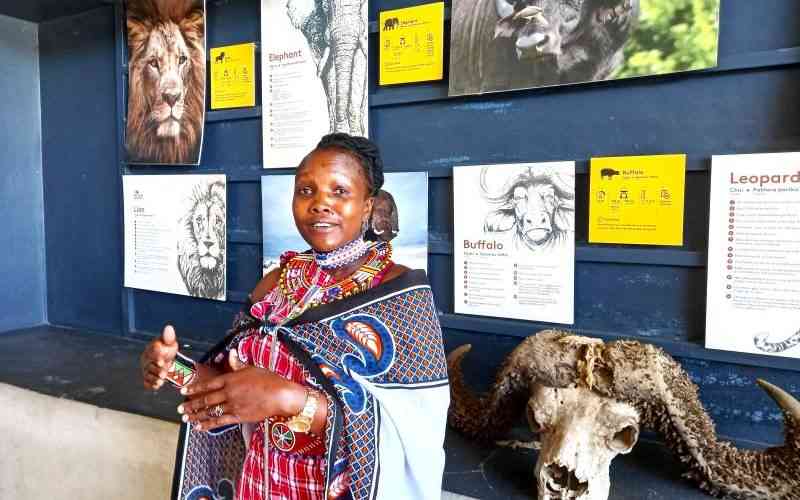
Leah Silantoi remembers the days when she would sit under an acacia tree and experiment with beading in Naroosura village, Narok county. For a small girl, it may have looked like a hobby, but in her culture, this prepared her for adulthood, a period when she will have to look after her family as a married woman.
“Like girls my age, I would just play with beads while boys looked after cattle,” says the mother of three. “There were no TVs in the area, so the lessons we got from beading or those the boys received while herding cattle came in handy later on in life. It may have been a leisure activity but pays off eventually.”
The enduring legacy of her childhood training is paying fruit as she coordinates and hosts guests at a cultural museum in the middle of Maasai Mara, a local repository of the vibrant culture and way of life for the pastoralist community. Enjoolata, the cultural centre within Basecamp Maasai Mara grounds, opened in 2020 but closed shortly thereafter due to Covid-19. It reopened the following year as global travel gained momentum.
The concept of Enjoolata stems from the Maasai manyatta, whose door reveals the beauty of something hidden from public view. “It is about the feelings you get when the door to the house opens to reveal several rooms, each serving a different purpose,” says Silantoi. “Here, we reveal information about the people who have shaped the destiny of this region since the dawn of history.”
According to Silantoi, culture is always evolving, and the Maasai way of life is no different. However, there are aspects of that culture that need to be preserved in a permanent repository for future generations.
These include the Maasai mode of dressing with the red shuka that has survived modern attire and that every Maasai dons from time to time as well as the rites of passage for young morans that serve as identifying marks of the men in the community.
With environmental conservation at the centre of modern living, Enjoolata is surrounded by a lush man-made forest, a contrast to the open grassland just across the Talek River. Many of the trees here have been planted by guests including some by Barack Obama and his family during their visit to Kenya in 2006.
From the entrance, a wide bazaar where the local community and guests gather greets you. The wide space means the air is always fresh despite the general humidity in the region.
However, do not expect Silantoi to lead you to the seats, not before a tour of the facility where you learn not only about the community’s culture but also the Maasai’s long-standing relationship with nature.
The community has a love affair with animals, both domestic and wild. The cattle rely heavily on the grass that is kept at optimum levels by wild grazers in the region such as buffaloes, zebras, and antelopes.
“Maasai lives revolve around cattle. In fact, a man without cattle is known as a ngirikoi or a nobody and is shunned by the community,” she says.
Likewise, wild animals are central to the local culture since Maasai clans are named after animals such as the elephant clan (ilaiser), or the hyena clan (Iltaarosero).
“This tells you why it is rare for Maasai to arbitrarily kill wild animals. These animals remind them of their family lineage. You cannot just get this information from your tour guide. It is revealed here,” says Silantoi.
At Enjoolata, there are abundant photo displays highlighting key aspects of animals that a typical guest may not be aware of. For example, many are surprised to know that about 8,000 wildebeest calves can be born on a single day, or as many as 500,000 calves born within the ecosystem between January and March.

Did you also know that giraffe mothers often return to their place of birth to deliver their babies? That baby drops five feet to the ground but can be up and running within an hour to avoid predators.
While most of us know of the Big Five, few can tell about the Small Five whose physical characteristics mirror the big ones: the elephant shrew with a protruding snout similar to the elephant trunk; the ant lion whose long pincers are designed to catch prey; the leopard tortoise whose shells mimic the leopard’s spots; the rhino beetle complete with ‘horns’; and the noisy red-billed buffalo weaver.
“Such information attracts university students, especially those from Moi University, wildlife clubs, and students from the Naivasha-based wildlife training institute.
At the far end of the centre sits a group of women engaging in beadwork as a means of supplementing their families’ income. Here, Branise Yiamoi leads the 198-strong team (though only about 40 are on-site at any given time) in the money-making venture that has seen the women educate their children, some to the university level.
“While beading earns the women some money, it is also a means of ensuring that this trade endures and is passed on to the next generation,” says Yiamoi who hails from Talek."